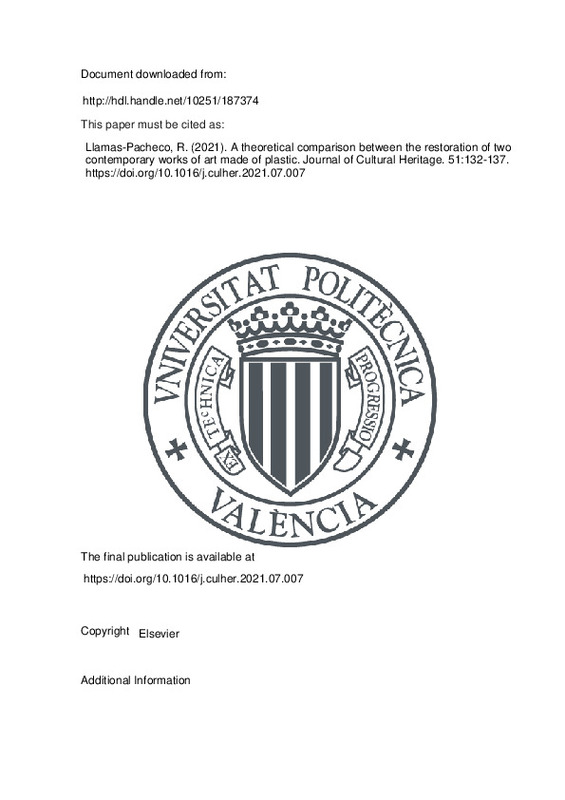JavaScript is disabled for your browser. Some features of this site may not work without it.
Buscar en RiuNet
Listar
Mi cuenta
Estadísticas
Ayuda RiuNet
Admin. UPV
A theoretical comparison between the restoration of two contemporary works of art made of plastic
Mostrar el registro sencillo del ítem
Ficheros en el ítem
| dc.contributor.author | Llamas-Pacheco, Rosario
|
es_ES |
| dc.date.accessioned | 2022-10-10T18:07:26Z | |
| dc.date.available | 2022-10-10T18:07:26Z | |
| dc.date.issued | 2021-08-24 | es_ES |
| dc.identifier.issn | 1296-2074 | es_ES |
| dc.identifier.uri | http://hdl.handle.net/10251/187374 | |
| dc.description.abstract | [EN] The article describes the intervention processes carried out on two contemporary artworks and analyzing them from a theoretical point of view. The first work of art, Silere, is an ink transfer on a moulded polymeric material. The second artwork is entitled Pasos en Falso, and consists of an installation that includes a pair of shoes made by the artist, layer by layer, with vinylic latex. The laces of these shoes are made from human hair. For each of the cases, a description is given of the material plane of the artwork, a description of its conceptual plane and a description of its biographical plane. It then discusses the paradigm in which each of them should be placed, and provides a hierarchy of their constituent elements, both in the material and immaterial planes. Finally, the discrepant factors that have determined the decision-making process are discussed. The study focuses not on the description of the intervention processes carried out, although these have been described for later discussion, but on the theoretical analysis that helps to understand the decision-making process, a decision-making process that is specific to each case. And this, applying the most advanced theoretical concepts on which the theory for the conservation of contemporary art is currently based, which have made it possible to compare the two interventions. In addition, the artworks that serve as examples are particularly interesting, as they have been made with polymeric materials, which, at the time of our intervention, were in a very poor condition. (c) 2021 Published by Elsevier Masson SAS. | es_ES |
| dc.language | Inglés | es_ES |
| dc.publisher | Elsevier | es_ES |
| dc.relation.ispartof | Journal of Cultural Heritage | es_ES |
| dc.rights | Reserva de todos los derechos | es_ES |
| dc.subject | Conservatio | es_ES |
| dc.subject | Contemporary art | es_ES |
| dc.subject | Theoretical analysis | es_ES |
| dc.subject | Polymer | es_ES |
| dc.subject | Decision-making | es_ES |
| dc.subject | New paradigms | es_ES |
| dc.subject.classification | PINTURA | es_ES |
| dc.title | A theoretical comparison between the restoration of two contemporary works of art made of plastic | es_ES |
| dc.type | Artículo | es_ES |
| dc.identifier.doi | 10.1016/j.culher.2021.07.007 | es_ES |
| dc.rights.accessRights | Abierto | es_ES |
| dc.contributor.affiliation | Universitat Politècnica de València. Departamento de Conservación y Restauración de Bienes Culturales - Departament de Conservació i Restauració de Béns Culturals | es_ES |
| dc.description.bibliographicCitation | Llamas-Pacheco, R. (2021). A theoretical comparison between the restoration of two contemporary works of art made of plastic. Journal of Cultural Heritage. 51:132-137. https://doi.org/10.1016/j.culher.2021.07.007 | es_ES |
| dc.description.accrualMethod | S | es_ES |
| dc.relation.publisherversion | https://doi.org/10.1016/j.culher.2021.07.007 | es_ES |
| dc.description.upvformatpinicio | 132 | es_ES |
| dc.description.upvformatpfin | 137 | es_ES |
| dc.type.version | info:eu-repo/semantics/publishedVersion | es_ES |
| dc.description.volume | 51 | es_ES |
| dc.relation.pasarela | S\453521 | es_ES |







![[Cerrado]](/themes/UPV/images/candado.png)

